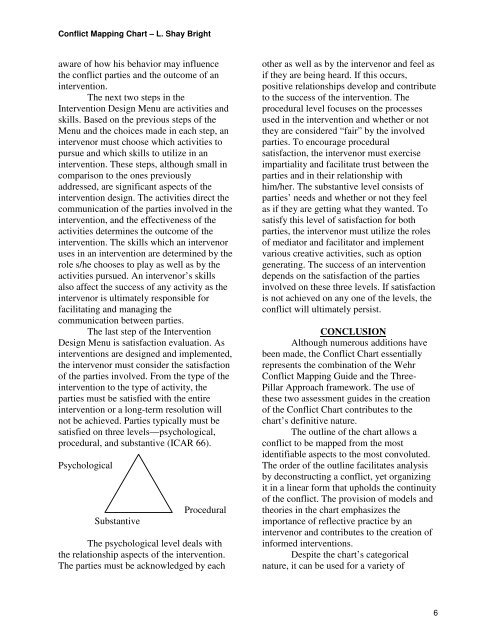The Conflict Mapping Chart By L. Shay Bright To ... - CMSupport.org
The Conflict Mapping Chart By L. Shay Bright To ... - CMSupport.org
The Conflict Mapping Chart By L. Shay Bright To ... - CMSupport.org
Create successful ePaper yourself
Turn your PDF publications into a flip-book with our unique Google optimized e-Paper software.
<strong>Conflict</strong> <strong>Mapping</strong> <strong>Chart</strong> – L. <strong>Shay</strong> <strong>Bright</strong><br />
aware of how his behavior may influence<br />
the conflict parties and the outcome of an<br />
intervention.<br />
<strong>The</strong> next two steps in the<br />
Intervention Design Menu are activities and<br />
skills. Based on the previous steps of the<br />
Menu and the choices made in each step, an<br />
intervenor must choose which activities to<br />
pursue and which skills to utilize in an<br />
intervention. <strong>The</strong>se steps, although small in<br />
comparison to the ones previously<br />
addressed, are significant aspects of the<br />
intervention design. <strong>The</strong> activities direct the<br />
communication of the parties involved in the<br />
intervention, and the effectiveness of the<br />
activities determines the outcome of the<br />
intervention. <strong>The</strong> skills which an intervenor<br />
uses in an intervention are determined by the<br />
role s/he chooses to play as well as by the<br />
activities pursued. An intervenor’s skills<br />
also affect the success of any activity as the<br />
intervenor is ultimately responsible for<br />
facilitating and managing the<br />
communication between parties.<br />
<strong>The</strong> last step of the Intervention<br />
Design Menu is satisfaction evaluation. As<br />
interventions are designed and implemented,<br />
the intervenor must consider the satisfaction<br />
of the parties involved. From the type of the<br />
intervention to the type of activity, the<br />
parties must be satisfied with the entire<br />
intervention or a long-term resolution will<br />
not be achieved. Parties typically must be<br />
satisfied on three levels—psychological,<br />
procedural, and substantive (ICAR 66).<br />
Psychological<br />
Substantive<br />
Procedural<br />
<strong>The</strong> psychological level deals with<br />
the relationship aspects of the intervention.<br />
<strong>The</strong> parties must be acknowledged by each<br />
other as well as by the intervenor and feel as<br />
if they are being heard. If this occurs,<br />
positive relationships develop and contribute<br />
to the success of the intervention. <strong>The</strong><br />
procedural level focuses on the processes<br />
used in the intervention and whether or not<br />
they are considered “fair” by the involved<br />
parties. <strong>To</strong> encourage procedural<br />
satisfaction, the intervenor must exercise<br />
impartiality and facilitate trust between the<br />
parties and in their relationship with<br />
him/her. <strong>The</strong> substantive level consists of<br />
parties’ needs and whether or not they feel<br />
as if they are getting what they wanted. <strong>To</strong><br />
satisfy this level of satisfaction for both<br />
parties, the intervenor must utilize the roles<br />
of mediator and facilitator and implement<br />
various creative activities, such as option<br />
generating. <strong>The</strong> success of an intervention<br />
depends on the satisfaction of the parties<br />
involved on these three levels. If satisfaction<br />
is not achieved on any one of the levels, the<br />
conflict will ultimately persist.<br />
CONCLUSION<br />
Although numerous additions have<br />
been made, the <strong>Conflict</strong> <strong>Chart</strong> essentially<br />
represents the combination of the Wehr<br />
<strong>Conflict</strong> <strong>Mapping</strong> Guide and the Three-<br />
Pillar Approach framework. <strong>The</strong> use of<br />
these two assessment guides in the creation<br />
of the <strong>Conflict</strong> <strong>Chart</strong> contributes to the<br />
chart’s definitive nature.<br />
<strong>The</strong> outline of the chart allows a<br />
conflict to be mapped from the most<br />
identifiable aspects to the most convoluted.<br />
<strong>The</strong> order of the outline facilitates analysis<br />
by deconstructing a conflict, yet <strong>org</strong>anizing<br />
it in a linear form that upholds the continuity<br />
of the conflict. <strong>The</strong> provision of models and<br />
theories in the chart emphasizes the<br />
importance of reflective practice by an<br />
intervenor and contributes to the creation of<br />
informed interventions.<br />
Despite the chart’s categorical<br />
nature, it can be used for a variety of<br />
6


